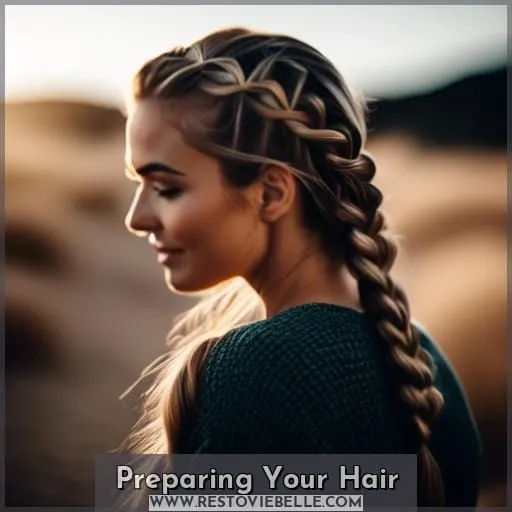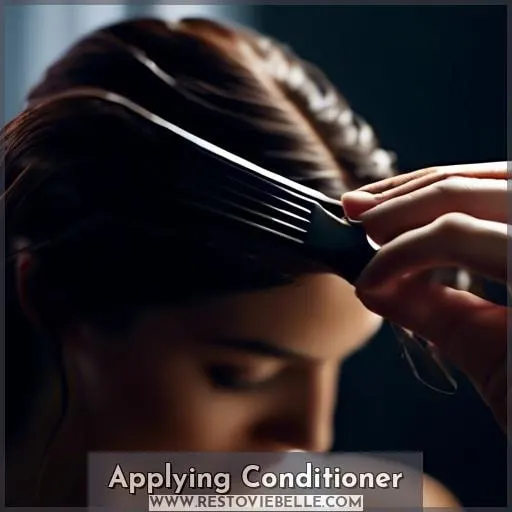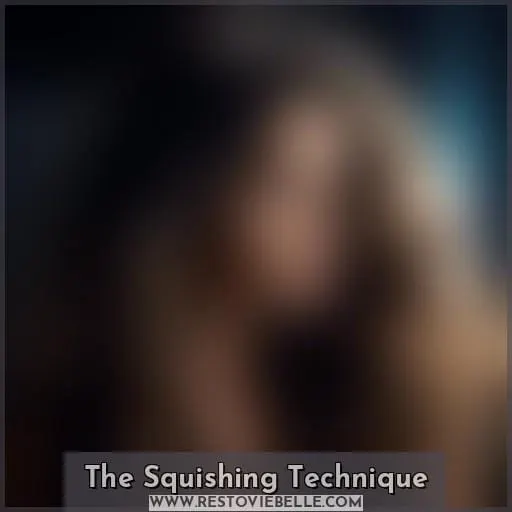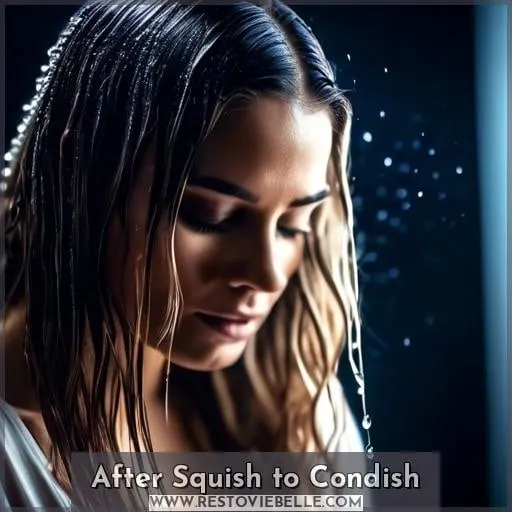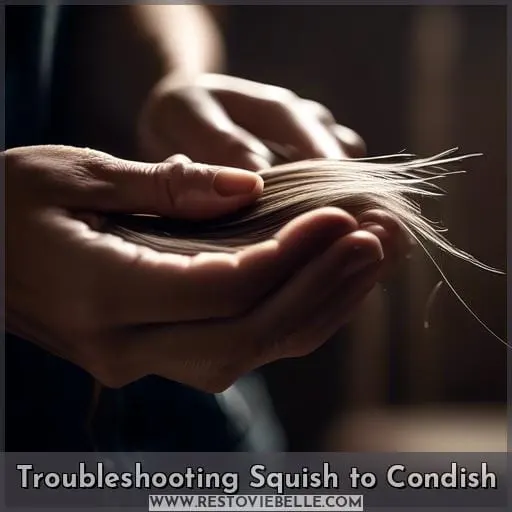This site is supported by our readers. We may earn a commission, at no cost to you, if you purchase through links.
 Dive into the oasis of hydration with squish to condish, your secret weapon against thirsty curls.
Dive into the oasis of hydration with squish to condish, your secret weapon against thirsty curls.
This transformative technique is your ally in the battle for bouncy, defined, and frizz-free curls. By squishing in moisture and sealing it with the right conditioner, you’re not just washing your hair; you’re embarking on a journey to unlock the full potential of your curls.
Embrace this guide as your roadmap to mastering the art of hydration and curl definition with squish to condish.
Table Of Contents
- Key Takeaways
- Squish to Condish Explained
- Choosing the Right Conditioner
- Preparing Your Hair
- Applying Conditioner
- The Squishing Technique
- Rinsing and Moisture
- After Squish to Condish
- Squish to Condish Variations
- Troubleshooting Squish to Condish
- Squish to Condish Frequency
- Frequently Asked Questions (FAQs)
- Can Squish to Condish be used on straight hair or is it exclusively for curly hair types?
- How does hard water impact the Squish to Condish method and are there any adjustments needed for those with hard water?
- Is it possible to over-moisturize hair using the Squish to Condish method, and if so, what are the signs?
- Can Squish to Condish be effectively combined with protein treatments, and how should they be alternated?
- How does the Squish to Condish method affect colored or chemically treated hair over time?
- Conclusion
Key Takeaways
The Squish to Condish method is a conditioning technique that enhances hydration and curl definition for curly and wavy hair, developed by Melissa Stites. This method not only boosts moisture levels in the hair but also promotes curl formation, improves scalp health, combats hair loss and damage, and strengthens hair to reduce breakage.
When selecting a conditioner for this method, it’s important to choose a silicone-free option with ingredients that can penetrate the hair cuticle, such as Bhringraj oil and fenugreek powder, to allow for better moisture penetration and nourishment without weighing down curls.
The technique involves using a sulfate-free cleanser or co-wash, detangling the hair, and then squishing a generous amount of conditioner into the hair with water, section by section, avoiding direct application to the scalp, and listening for a squelching sound to ensure proper hydration.
Squish to Condish Explained
If you’re looking to enhance your curly or wavy hair’s hydration and definition, the Squish to Condish (STC) method is a game-changer. This technique involves squishing conditioner into your hair with water, sealing the cuticles, and reducing frizz for smoother, more manageable curls.
The STC method was developed by curly hair expert Melissa Stites and has since become a staple in the curly-hair community. It’s designed to provide intense hydration by helping the conditioner penetrate deeper into the hair shaft, which is particularly beneficial for curly hair that tends to be drier and more prone to frizz.
By squishing the conditioner into the hair, you encourage the formation of well-defined curl clumps, leading to enhanced curl definition and overall hair health.
To properly execute the Squish to Condish method, start with clean, wet hair. Apply a generous amount of silicone-free conditioner, finger comb to detangle, and then flip your head upside down to squish the conditioner into your hair with water.
The goal is to hear a squelching sound, indicating that the hair is fully saturated with conditioner. This method doesn’t require rinsing and can be followed by air drying to further enhance curl formation.
In summary, Squish to Condish is a conditioning technique that boosts moisture and curl definition for curly and wavy hair. It’s a simple yet effective method that can transform your hair care routine and lead to healthier, more vibrant curls.
Benefits for Curly Hair
Embrace the transformative power of ‘Squish to Condish’ for your curly hair, and you’ll be saying goodbye to frizz and hello to luscious, defined curls. This technique isn’t just a trend; it’s a moisture miracle that encourages your curls to clump together like best friends at a dance party, leaving them stronger and ready to bounce back from anything—like a yoga master of hair flexibility.
Here’s a quick rundown of the benefits you’ll reap:
- Squish to condish boosts your hair’s moisture levels, which is like giving your thirsty curls a long, refreshing drink.
- It’s a champion for curl formation, turning unruly strands into an organized curl squad.
- By promoting scalp health and hair growth, it’s like a personal trainer for your hair follicles, keeping them fit and productive.
- This method also combats hair loss and hair damage, acting like a superhero shield against the daily battles your hair faces.
Origin and Popularity
You’ve probably heard the buzz about Squish to Condish (STC) and for good reason—it’s like a magic potion for your curls! This technique isn’t just a passing trend; it’s a curly hair game-changer with deep historical roots in the curly community.
Dreamed up by curly hair maestro Melissa Stites, STC has taken the hair world by storm, earning nods from celebs and curl enthusiasts alike. It’s all about locking in that precious moisture, transforming thirsty locks into luscious, defined curls.
Whether you’re a curly queen or a wavy wonder, STC is your ticket to hair wellness and those envy-inducing, bouncy spirals.
Choosing the Right Conditioner
When selecting the right conditioner for the Squish to Condish method, it’s essential to choose a silicone-free option that can penetrate the hair cuticle effectively.
You’ll want a conditioner that hydrates and strengthens without weighing down your curls. Ingredients that can easily penetrate the hair, such as water, Bhringraj oil, fenugreek powder, and horsetail extract, are beneficial for maximizing moisture absorption and promoting healthy hair growth.
Silicone-Free Options
Continuing from the squish to condish method, let’s dive into the world of silicone-free options.
- Silicone alternatives allow for better moisture penetration enhancers.
- Natural ingredients nourish without weighing down your waves.
- Curl-defining benefits come from hair-healthy formulas.
- A silicone-free conditioner is a must-have tool in any deva-certified stylist’s arsenal.
Ingredients for Penetration
You want your conditioner to not just coat your hair, but to penetrate the hair shaft for that deep moisture treatment. Think of your hair cuticle like a thirsty flower—water and the right nutrients are key to keeping it vibrant.
When you’re upside down, squishing in that conditioner, imagine each strand drinking up the goodness, curl by curl. Finger comb to ensure every hair is quenched, and when you hear that squelch, you’ll know you’re on the right track.
No rinse needed just yet—let those hair cuticles feast!
Preparing Your Hair
To prepare your hair for the Squish to Condish (STC) method, start with a clean slate by washing your hair with a sulfate-free cleanser or co-wash.
Ensure your hair is thoroughly detangled to allow for the smooth application of conditioner.
Cleansing and Wetting
After selecting the right silicone-free conditioner, it’s time to ensure your naturally curly hair is primed for squish to condish. This method is all about maximizing hydration, so proper cleansing and wetting are crucial.
- Begin with a clean slate by using a clarifying shampoo to remove any scalp buildup and product residue, but be wary of excessive clarifying which can lead to hair dryness.
- Wet your hair thoroughly; this isn’t just a splash-and-go situation. Your curls should be drenched to allow for the conditioner to spread evenly.
- If you’re dealing with a tangled mane, gently detangle your hair while it’s wet to prevent breakage and ensure the conditioner coats every strand.
- Remember, the squish to condish method is all about getting that moisture into the hair cuticles, so make sure your hair is soaking wet before you start squishing.
Now, with your hair prepped and primed, you’re ready to dive into the squish to condish technique and give your curls the hydration they’ve been thirsting for!
Detangling Tips
After cleansing your locks, it’s time to tackle those tangles.
For wavy/loose curls or tight curl types, the right detangling techniques can make or break your curl care routine. Reach for a wide-toothed comb or a specialized brush for curly hair to gently work through knots.
Wet detangling is often preferred, as the hair is more pliable and less prone to breakage when saturated with water and conditioner. Apply a generous amount of a slippery conditioner like the GRO Revitalizing Conditioner or a deep conditioner to ease the process.
Applying Conditioner
When applying conditioner using the Squish to Condish (STC) method, it’s essential to be generous with the product.
Start by applying a liberal amount of conditioner to your wet hair, ensuring even distribution.
As you work the conditioner through your strands, use your fingers to detangle and remove any knots, promoting smooth and manageable curls.
Generous Application
After you’ve cleansed and detangled your locks, it’s time to lavish them with conditioner. Don’t skimp—drench your hair in it! Think of conditioner quantity like the avocado in your superfood salad; the more, the merrier.
As you finger comb, imagine you’re untangling the mysteries of the universe, each strand a secret to curl definition.
Take a cue from Melissa Stites and her curl tips—squish to condish isn’t just a technique, it’s a curl revolution.
Finger Combing Technique
After lathering on a generous amount of conditioner, it’s time to get down to the nitty-gritty with finger combing.
- Start with finger combing to evenly spread the conditioner, targeting those pesky tangles.
- The conditioner consistency should be just right—not too thick, not too runny—to glide through your hair.
- Gently work through knots for effective tangle removal without causing breakage.
- Use this application method to prep your hair for the squish to condish magic, ensuring maximum hair hydration.
The Squishing Technique
To encourage curl clumps and listen for the squelch, you’ll want to focus on the squishing technique during your conditioning routine.
This method is all about enhancing your hair’s moisture levels and defining your curls. As you squish the conditioner into your hair, listen for the squelching sound, which indicates that you’re effectively saturating your strands with moisture.
Encouraging Curl Clumps
To master the squish to condish method, focus on clump size and product distribution.
Begin by sectioning hair to ensure even conditioner application. Protect your scalp by avoiding direct application, and consider conditioner alternatives if your usual choice weighs down your curls.
Listening for the Squelch
Listening for the squelch is your golden ticket to mastering the Squish to Condish (STC) technique.
This squelching sound is music to a curly hair enthusiast’s ears because it signals that water and conditioner are mingling perfectly, ensuring cuticle penetration and strand hydration.
Achieving this sound means you’re on the right track to maximizing conditioner absorption and boosting your hair’s moisture levels. So, don’t just listen for it; chase it! It might feel a bit odd at first, like you’re making a mess, but trust the process.
With practice, you’ll find that this squelchy serenade is the prelude to beautifully hydrated and defined curls.
Rinsing and Moisture
To effectively rinse and hydrate your hair using the Squish to Condish (STC) method, you’ll need to master the technique of cupping water and working it through your curls.
This process is essential for ensuring that your hair is thoroughly moisturized and that the conditioner is evenly distributed. As you squish the conditioner-water mixture into your hair, listen for the squelching sound, which indicates that you’re doing it correctly.
With practice, this method will help your curls retain moisture and enhance their definition.
Cupping Water for Rinsing
When it comes to rinsing your hair during the Squish to Condish (STC) method, it’s all about technique and attention to detail.
- Water Temperature: Use cool water to help seal the cuticles and lock in moisture.
- Cup Size: Your hands are your cups; gather enough water to saturate your curls.
- Squishing Duration: Spend a few minutes on this step to ensure thorough conditioning.
- Hand Position: Cup and squish from the ends upward to encourage curl formation.
Assessing Hydration Levels
After cupping water and squishing it through your curls, it’s time to assess hydration levels. You’re aiming for that just-right moisture balance where your curls feel like they’ve had a satisfying drink without being drenched.
Look for hydration indicators like curl clumping and a reduction in the rate at which water drips from your hair.
After Squish to Condish
After completing the Squish to Condish method, it’s essential to handle your curls gently to maintain the moisture and definition achieved.
Air drying is the preferred method to enhance and set your curls without disrupting their natural pattern.
Air Drying for Definition
After you’ve squished to condish, embracing the air drying process is your next step to luscious, defined curls.
- Resist the urge to towel-dry: Rubbing your hair with a towel can rough up the cuticle, leading to frizz. Instead, gently scrunch with a microfiber towel or cotton t-shirt to remove excess water.
- Keep your hands off: It’s tempting to touch your curls, but hands off! Manipulating your hair while it’s drying can disrupt the curl pattern and invite frizz.
- Use a leave-in conditioner or curl cream: Apply your favorite product to help with frizz reduction and definition. Scrunch it in to encourage curl formation.
- Find a good spot to air dry: Settle in a warm room with good air circulation. Avoid going outside if it’s humid or rainy, as this can affect your drying time and curl definition.
Squish to Condish Variations
Whether you’re enhancing waves or defining tight curls, the squish to condish method can be tailored to your hair’s needs.
It’s all about adjusting the technique to maximize hydration and curl definition for your unique texture.
For Wavy Hair
For those with wavy hair, mastering the Squish to Condish technique can be a game-changer. It’s all about hitting that sweet spot of moisture balance to keep frizz at bay and let those waves shine.
Imagine your hair as a sponge; you want it to soak up just the right amount of moisture without getting waterlogged. Too much and you’ll drown out your waves, too little and they’ll be thirstier than a cactus in the desert.
The key is to listen to your hair’s needs and respond with a conditioner that’s just right—not too heavy, not too light. It’s like being a hair whisperer, understanding the unique language of your locks.
With a bit of practice, you’ll have those waves behaving like well-trained dolphins at SeaWorld.
For Tight Curls
For those with tight curls, the Squish to Condish (STC) method is a game-changer. It’s not just about slathering on conditioner; it’s an art form that transforms thirsty locks into luscious spirals.
- Defining Tight Curls: STC helps in sculpting your curls into well-defined artworks, making each strand pop with vitality.
- Moisturizing Dry Curls: This method infuses your curls with moisture, turning brittle strands into soft, touchable spirals.
- Controlling Frizz: By locking in hydration, STC tames the wild frizz, giving you a sleek, polished look.
- Enhancing Curl Definition: The technique encourages your curls to clump together, enhancing their natural pattern and reducing breakage.
Embrace the STC method and watch your tight curls thrive with vibrancy and bounce.
Troubleshooting Squish to Condish
If you’re experiencing issues with the Squish to Condish (STC) method, it’s important to adjust your technique.
You may need to experiment with the amount of conditioner used or the amount of water you squish into your hair.
It’s crucial to listen to your curls and modify the process until you achieve the desired hydration and definition.
Common Challenges
When diving into the Squish to Condish method, you might hit a snag with product buildup, leaving your locks feeling like a bird’s nest.
If your hair’s throwing a fit with dullness, itchiness, or flakiness, you’ve likely gone overboard with the conditioner.
Adjusting the Technique
If you’ve been wrestling with the Squish to Condish (STC) method and not quite hitting the mark, don’t fret! Adjusting your technique could be the game-changer you need.
And here’s a hot tip: a leave-in conditioner can be a curly hair’s best friend, especially if you’re prone to scalp irritation. It’s like finding the perfect dance partner for your hair type—once you’ve got the rhythm, you’ll be twirling through your hair care routine with ease.
Squish to Condish Frequency
When determining how often to incorporate the Squish to Condish (STC) method into your hair care routine, it’s essential to listen to your hair’s needs.
The frequency of STC can vary based on your hair’s condition and how often it requires hydration and curl definition. For most individuals with curly hair, applying this technique once or twice a week is sufficient to maintain moisture and enhance curls.
However, if your hair is particularly dry or damaged, you may benefit from using STC every time you condition your hair. Conversely, if your hair feels heavy or weighed down, you might want to reduce the frequency to every other shampoo.
It’s important to observe how your hair responds and adjust accordingly.
When to Repeat
When it comes to mastering the Squish to Condish (STC) method, it’s crucial to find the sweet spot for repetition. Overdoing it can lead to conditioner buildup, while not doing it enough might leave your curls thirsty.
- Listen to your locks: Your hair’s texture changes will signal when it’s time for another STC session.
- Avoid over-moisturizing: Too much of a good thing can lead to limp, lifeless curls.
- Watch for scalp irritation: This could indicate you’re squishing too often.
- Seek balance: Alternate with clarifying washes to prevent buildup.
- Tailor to your tresses: Product recommendations vary, so find what works for your unique hair type.
Listening to Your Hair
Listening to your hair is key when determining how often to employ the squish to condish technique. Your curls will communicate their needs, so pay attention to their hydration levels.
If your locks start to feel parched or your curls lack definition, it’s time for a squish session. Remember, the squish technique isn’t just about slathering on conditioner; it’s about the art of conditioner application, hair preparation, and the rinsing process.
It’s a dance of moisture, with each step choreographed to ensure your hair drinks in every drop. So, tune in to your tresses and let them lead the way to luscious, hydrated curls.
Frequently Asked Questions (FAQs)
Can Squish to Condish be used on straight hair or is it exclusively for curly hair types?
Squish to Condish is a hair treatment that is loved by curly heads, but it’s not exclusive to them. Straight hair can also benefit from the moisture boost and smoothness it provides.
Here’s how you can do it:
-
Wash your hair with a gentle shampoo and rinse thoroughly.
-
Apply a generous amount of conditioner to your hair, focusing on the ends.
-
Gently squeeze the conditioner into your hair with your hands, making sure it’s evenly distributed.
-
Let the conditioner sit for a few minutes to allow it to penetrate your hair.
-
Rinse your hair with cool water to lock in the moisture.
This treatment can be done once a week or as needed to keep your hair looking healthy and smooth.
How does hard water impact the Squish to Condish method and are there any adjustments needed for those with hard water?
Hard water can leave mineral deposits on your hair, making it harder for moisture to penetrate during the Squish to Condish method. You might need to use a chelating or clarifying shampoo occasionally to remove buildup.
Is it possible to over-moisturize hair using the Squish to Condish method, and if so, what are the signs?
You might think you’re giving your locks the royal treatment with Squish to Condish, but beware of overindulgence!
Over-moisturizing can turn your hair into a lifeless, frizz-prone mess. If your curls are more limp than a wet noodle, feel mushy, or can’t hold their shape, you’ve likely gone overboard.
Can Squish to Condish be effectively combined with protein treatments, and how should they be alternated?
Yes, Squish to Condish can be effectively combined with protein treatments.
Alternate them based on your hair’s needs: if it feels mushy or overly soft, add a protein treatment; if dry or stiff, focus on moisture.
Listen to your locks—they’ll tell you what they crave!
How does the Squish to Condish method affect colored or chemically treated hair over time?
Imagine your hair as a delicate silk fabric; just as you’d handle it with extra care, the Squish to Condish method treats your colored or chemically treated hair gently.
Over time, it enhances moisture retention, reduces frizz, and maintains the vibrancy of your color, much like a fabric softener preserves the luster of silk.
Conclusion
Just like a desert thirsts for rain, your curls have been longing for the squish to condish method—a true oasis of hydration.
By now, you’re equipped with the knowledge and techniques to transform your hair into bouncy, defined, and frizz-free curls.
Your journey doesn’t end here; it’s an ongoing adventure of listening to your hair and adjusting the routine as needed.
So, dive in, squish to condish, and watch your curls flourish like never before.


